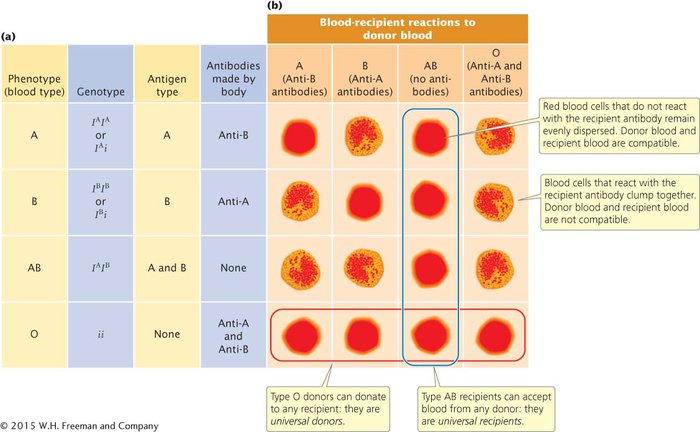Multiple Alleles
Most of the genetic systems that we have examined so far consist of two alleles. In Mendel’s peas, for instance, one allele encoded round seeds and another encoded wrinkled seeds; in cats, one allele produced a black coat and another produced a gray coat. For some loci, more than two alleles are present within a group of individuals—
THE ABO BLOOD GROUP A multiple-

The body produces antibodies against any foreign antigens (see Figure 4.16a). For instance, a person with blood type A produces anti-
The inheritance of alleles at the ABO locus is illustrated by a paternity suit against the movie actor Charlie Chaplin. In 1941, Chaplin met a young actress named Joan Barry, with whom he had an affair. The affair ended in February 1942, but 20 months later, Barry gave birth to a baby girl and claimed that Chaplin was the father. Barry then sued for child support. At this time, blood typing had just come into widespread use, and Chaplin’s attorneys had Chaplin, Barry, and the child blood typed. Barry had blood type A, her child had blood type B, and Chaplin had blood type O. Could Chaplin have been the father of Barry’s child?
Your answer should be no. Joan Barry had blood type A, which can be produced by either genotype IAIA or genotype IAi. Her baby possessed blood type B, which can be produced by either genotype IBIB or genotype IBi. The baby could not have inherited the IB allele from Barry (Barry could not carry an IB allele if she were blood type A); therefore, the baby must have inherited the i allele from her. Barry must have had genotype IAi, and the baby must have had genotype IBi. Because the baby girl inherited her i allele from Barry, she must have inherited the IB allele from her father. Having blood type O, produced only by genotype ii, Chaplin could not have been the father of Barry’s child. Although blood types can be used to exclude the possibility of paternity (as in this case), they cannot prove that a person is the parent of a child, because many different people have the same blood type.
In the course of the trial to settle the paternity suit against Chaplin, three pathologists testified that it was genetically impossible for Chaplin to have fathered the child. Nevertheless, the jury ruled that Chaplin was the father and ordered him to pay child support and Barry’s legal expenses.  TRY PROBLEM 32
TRY PROBLEM 32
COMPOUND HETEROZYGOTES Different alleles often give rise to the same phenotype. For example, cystic fibrosis, as we saw earlier in this chapter, arises from defects in alleles at the CFTR locus, which encodes a protein that controls the movement of chloride ions into and out of the cell. Over a thousand different alleles at the CFTR locus that can cause cystic fibrosis have been discovered worldwide. Because cystic fibrosis is an autosomal recessive condition, one must normally inherit two defective CFTR alleles to have cystic fibrosis. In some people with cystic fibrosis, these two defective alleles are identical, meaning that the person is homozygous. Other people with cystic fibrosis are heterozygous, possessing two different defective alleles. An individual who carries two different alleles at a locus that result in a recessive phenotype is referred to as a compound heterozygote.
CONCEPTS
More than two alleles (multiple alleles) may be present at a locus within a group of individuals, although each individual diploid organism still has only two alleles at that locus. A compound heterozygote possesses two different alleles that result in a recessive phenotype.